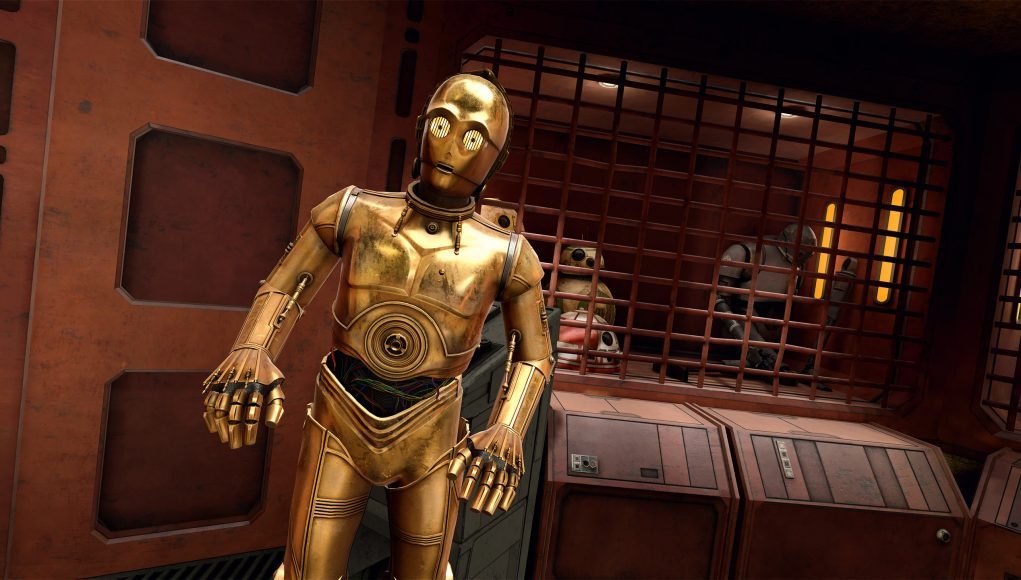Star Wars: Tales from the Galaxy’s Edge marks a clear departure from ILMxLAB’s Vader Immortal series, bringing gameplay to the forefront and using its campaign as a platform for further narrative-driven experiences, which will be available on a rolling basis in successive paid DLC packs. Galaxy’s Edge does an admirable job of approaching the sort of visual richness we tend to see in PC VR games, and the surrounding story is well orchestrated, but the meat of the game’s VR shooter campaign was a bit too basic to truly fall in love with.
Star Wars: Tales from the Galaxy’s Edge Details:
Available On: Oculus Quest
Release Date: November 19th, 2020
Price: $25
Developer: ILMxLAB
Reviewed On: Quest 2
Gameplay
Star Wars: Tales from the Galaxy’s Edge puts you in the shoes of a droid technician whose ship is boarded by a band of Guavian Death Gang pirates while in orbit above the desert planet Batuu. The First Order is offering up serious cash for some mysterious cargo in your ship’s hold, but under the threat of death you jettison the precious cargo and flee the ship, finding yourself back at Batuu’s Black Spire Outpost where you battle the pirates in your search of the cargo.
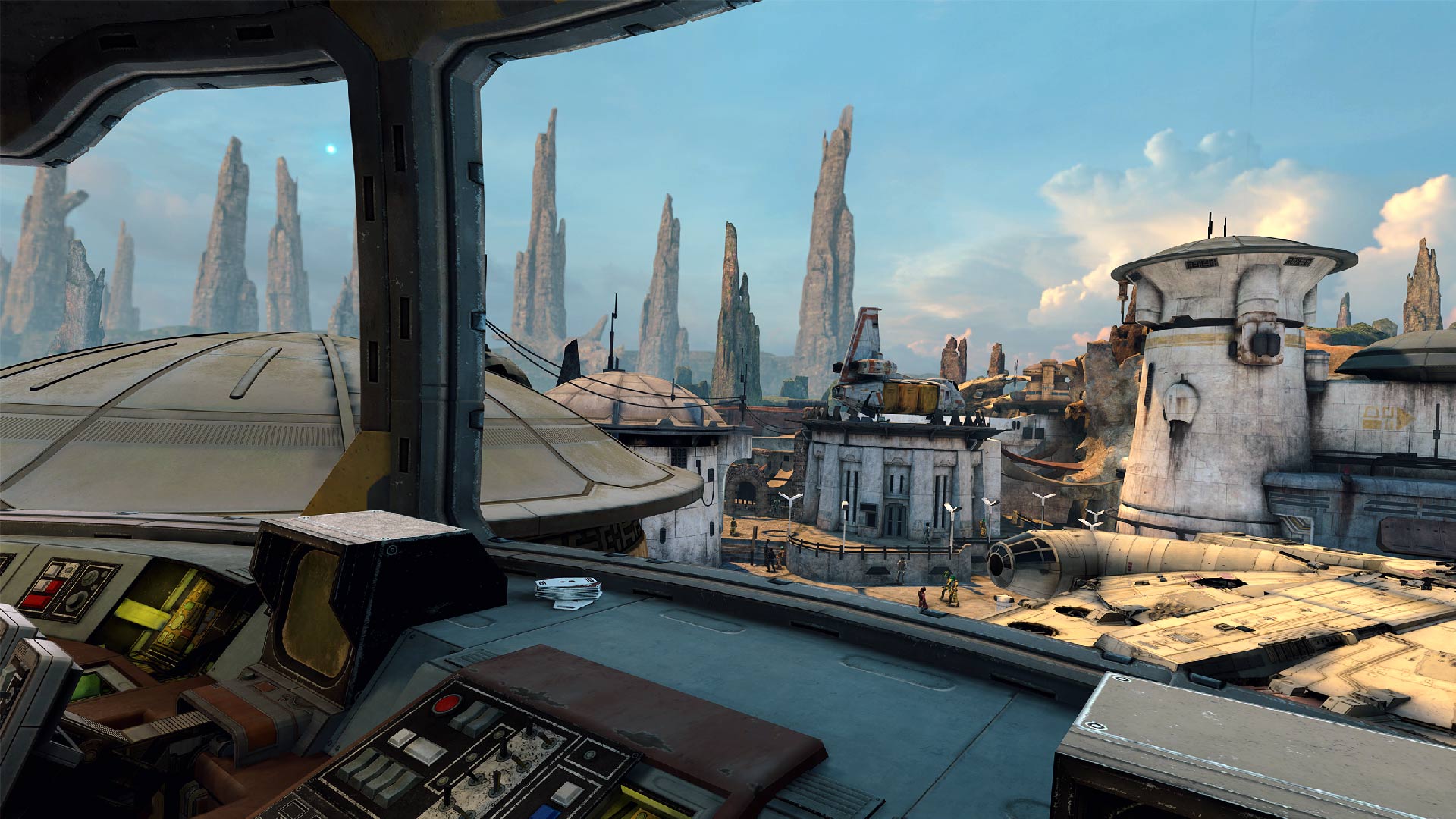
Unlike Vader Immortal, Galaxy’s Edge pushes its theme park-style smorgasbord of adventure experiences to its ‘Tales’ DLC, instead offering up a shooter-based campaign for the game’s main course. At launch, it’s a significant chunk of the game, with post-campaign DLC designed to serve up more of that diverse mix of Jedi thrills seen in Vader Immortal. I’ll talk more about DLC below, but first the main campaign.
Galaxy’s Edge’s campaign is fairly basic shooter fare. Moving through a few of the pirates bases on the edge of the Outpost—making for a half dozen standalone levels—you’ll find a mix of bipedal baddies, flying droids, and wild creatures abound to blast away at.

Having that mix of flying and ground enemies is good, but all of them are essentially bullet sponges, which unfortunately dumbs down gameplay overall. That’s not to say there aren’t some high points to the campaign—you get to meet some familiar characters and wield iconic Star Wars weapons—but I can’t say I was ever wowed by a single encounter, the sole boss fight at the end included. Basically you blast until everything falls over, and walk to the next section of the map with little variation.
As unexciting as enemy encounters felt, I enjoyed the overall shooting experience. In Galaxy’s Edge, weapons include a variety of single-handed blasters that you either scavenge from downed enemies or find in unlockable weapons crates.
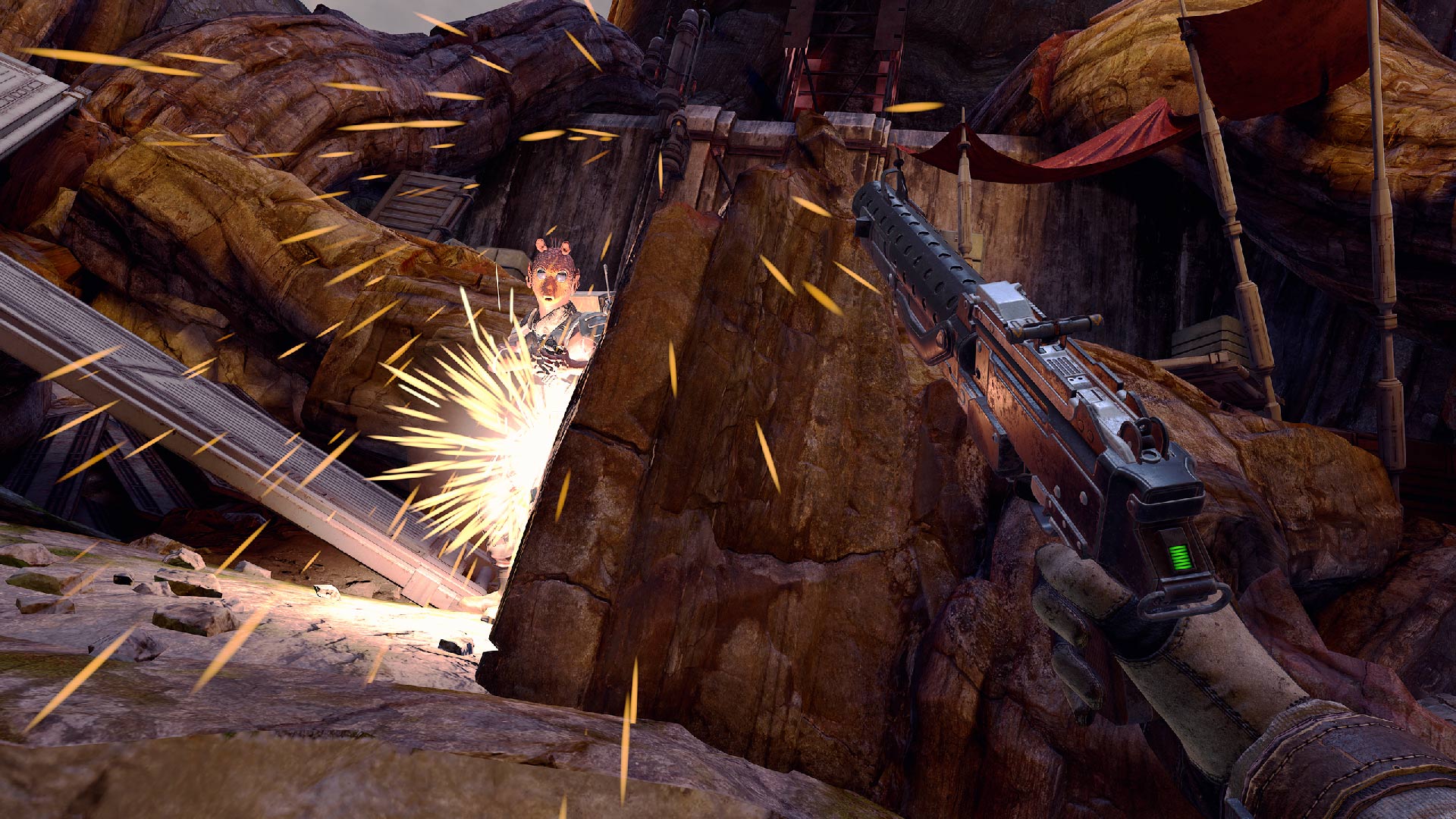
All weapons are consumable, with some depleting their batteries more rapidly than others. Instead of fumbling for a mag and reloading, each gun comes with a charging slider on the top rail, which also acts as the gun’s rear iron sight. Each shot from the gun moves the slider a bit further away until you need to pull it back again to reload. A handy color-coded display near the grip tells you how much juice is left until you need to throw it away and look for a new one. It’s a nice VR-native reload style I haven’t seen before, and although arcadey, it’s a sci-fi world of magic and talking robots, so it fits pretty well considering.
In addition to guns and a single thermal grenade type, there’s also three types of flying droids that you can deploy to help you automatically take down enemies. Oftentimes I would toss out three seeker types that would bomb out a level before going in, or toss out either shielded and unshielded shooter types to act as support fire. You can only use three of any type at a time, but you can also repair damaged shooter droids with your multitool, which I thought was a nice touch.
The multitool was another pleasant surprise. The pistol-like device has three interchangeable tips you can cycle through: a screwdriver, a flame torch, and an electric spark. It’s most useful in opening weapons lockers, which require multiple steps. Oftentimes you’ll need to unweld an access panel, unlock a mechanism with your screwdriver, and bridge two circuits with your spark tip just to open one locker.
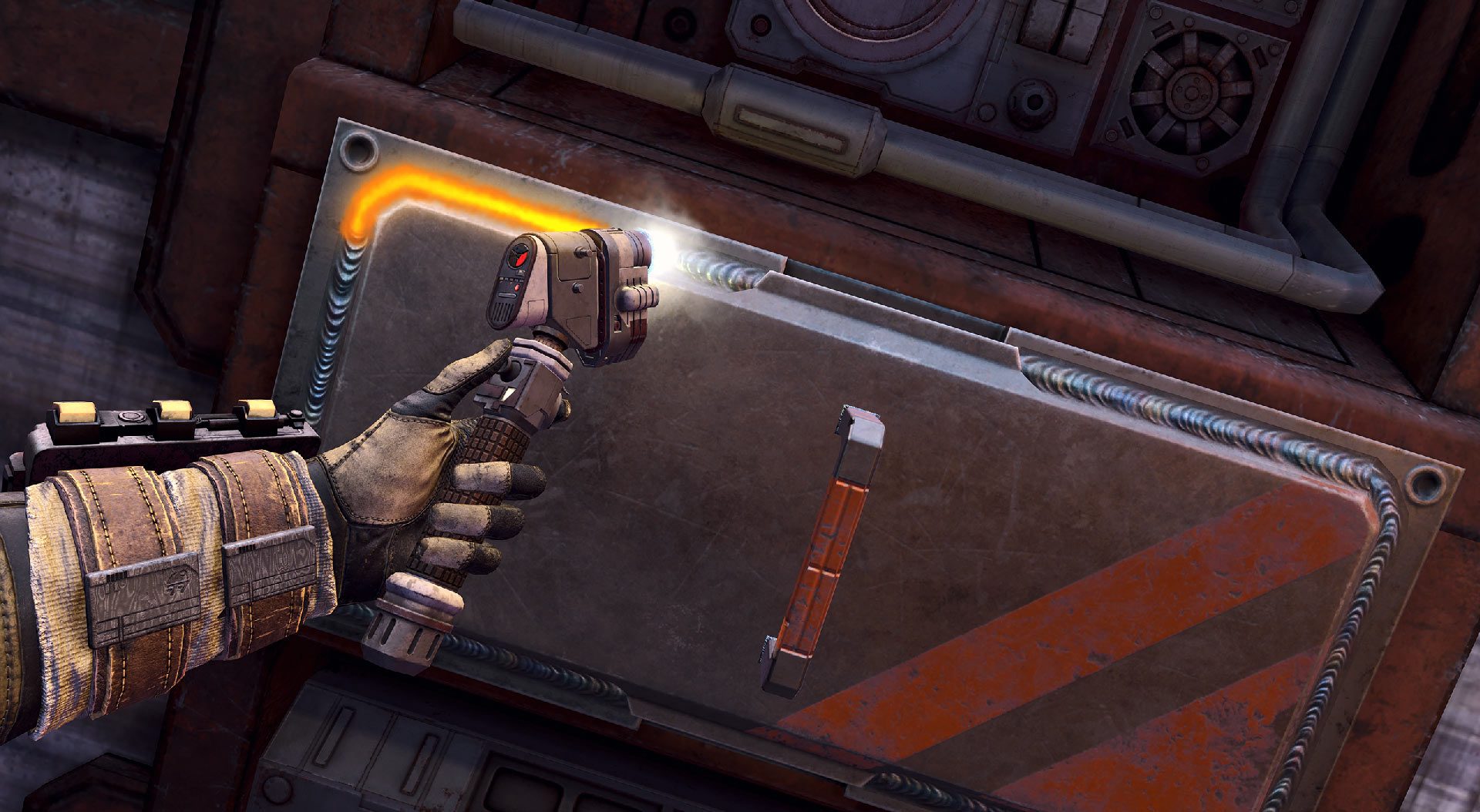
Levels are one-way journeys with discrete entry and end points, however they offer up secret areas to explore too. Because there aren’t many key items or any one-off weapons to search for in the game, more often than not secret areas are momentary detours housing crates with health packs, grenades, basic guns, and target droids, and plenty of junk to salvage. You may also find one of 12 mini-droids, the main collectible item.
Only approaching the very end are you given a chance to spend your credits in a shop, which feels like a missed opportunity. The only merchandise available includes standard items and an assortment of different glove skins. Still, it was nice to have tons of droids and health packs for the final boss fight, but I still would have liked to see the shop better integrated into the game from the very beginning, which would have brought some sense to all of the trash and credit collecting you’ll do throughout the majority.
The campaign mission took me a little under three hours to complete on normal difficulty (easy and hard are available), which included the main objectives and most of the additional side objectives. In the end, the campaign felt like the first level in a much grander game, which hypothetically might have given it more room to tease out more diverse enemy types, larger and more interesting levels, and grander, more clever boss fights.
Temple of Darkness DLC (included)
One of those side objectives during the campaign is to gather ingredients for a special drink, which Seezelslak prepares back at the cantina so he can recount his first tale, the only extra DLC at launch.
Called ‘Temple of Darkness’, Seezelslak’s story transports you to the past, hundreds of years before the events of Star Wars: The Phantom Menace. There you take on the role of Padawan Ady Sun’Zee to work alongside Jedi Master Yoda. Like Luke Skywalker on Dagobah, you have to overcome both the literal and metaphorical darkness along your quest to become a Jedi master.
In ‘Temple of Darkness’, you’re finally handed a lightsaber, and given the ability to cinematically slash down baddies from the very moment you approach the temple.
I won’t spoil the inside of the temple, however you’ll make use of the powers you learned in Vader Immortal, including force powers and the ability to sling your light saber through the air like a boomerang. It’s well done (also, there’s Yoda, which is cool) but it was surprisingly short at only 15 minutes. I was honestly expecting a Vader Immortal-size experience, but maybe that will be something for future DLC to beef out.
Immersion
ILMxLAB astounds me with its ability to bring high-quality visuals to the Quest platform, and it doesn’t disappoint with Galaxy’s Edge. Characters are well animated, textures are high quality, and although environmental visual quality could be more consistent throughout—some popping occurs and background vistas appear flat—it leaves you in a rich and solid environment that feels much more like a PC VR game than one built for Quest.
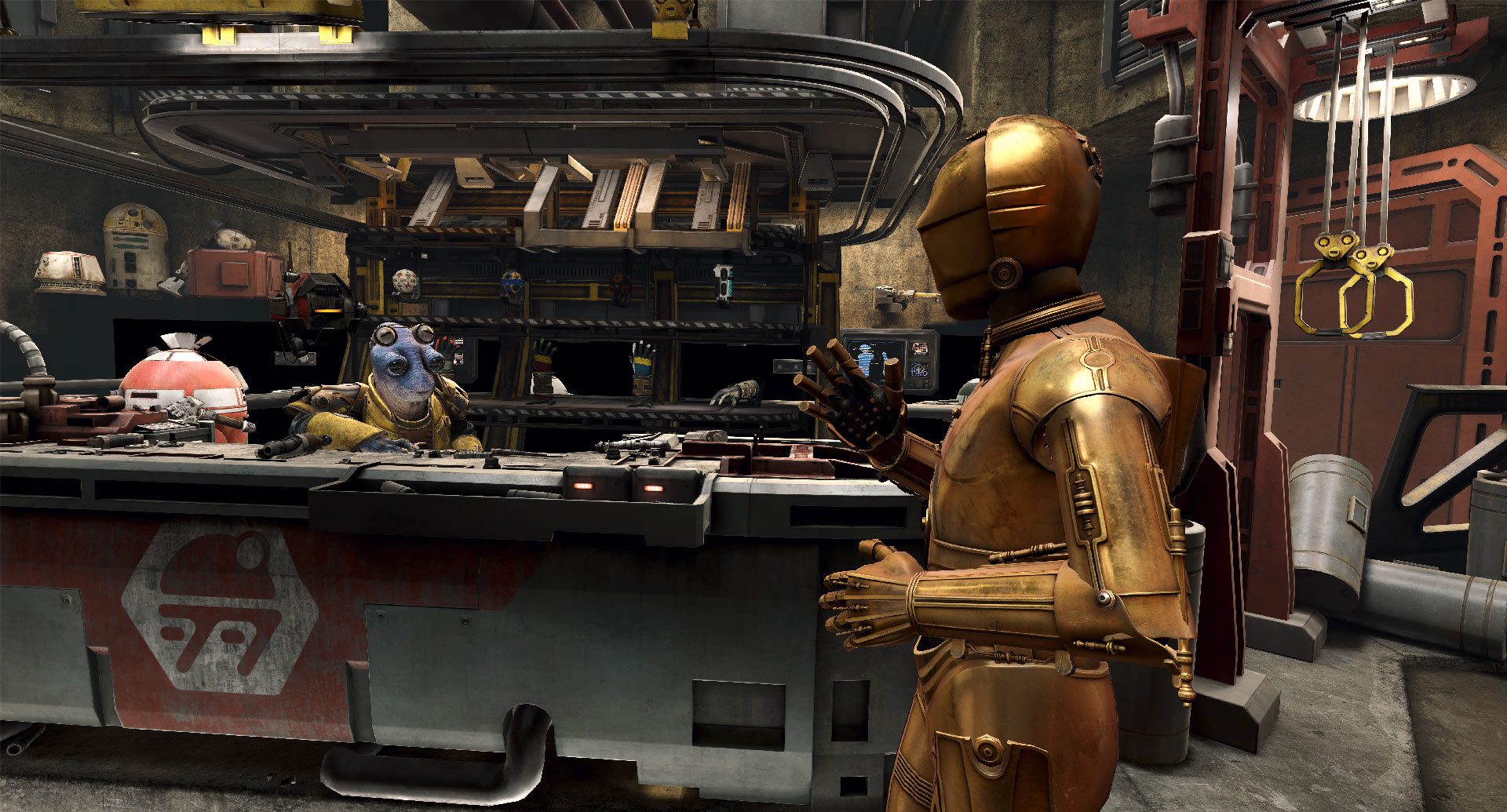
Audio quality is second to none too. The game’s music was fantastic, featuring Emmy-award winner Bear McCreary (campaign), Danny Piccione (cantina music), and Joseph Trapanese (‘Temple of Darkness’). Voice acting was also great, with C-3P0 voiced by original actor, Anthony Daniels, and Yoda voiced by the series’ puppeteer and voice actor, Frank Oz.
Object interaction is fairly good too, giving the user force grab and the ability to easily switch objects between hands if need be, which is something developers tend to forget. You can pick up nearly everything, but the game’s good object interaction is hampered somewhat by its inventory, which is a mixed bag.
I liked having two slots for guns on both sides, two slots for heath packs on my gloves, and an expandable inventory pack on my chest holding everything else—but that chest pack is so strangely organized that it becomes virtually useless during combat. Items automatically fill up in the first slots, which is fine if you could reorganize them easily to make a sort of hotbar of most used items. Because you can’t move stacks of items, instead being forced to move items one at a time, it becomes a real chore in setting up an inventory that’s actually useable in a fight—which is all the time. I really wish there were a better holster system to hold all important items, including droids, doing away with the inventory pack completely.
Comfort
You’re given the choice between smooth locomotion and teleportation, although it’s clear Galaxy’s Edge was designed around teleportation first. Most levels require you to teleport to get across gaps and reach high places, even if you’ve chosen smooth locomotion as an option. This was done to accommodate for the lack of jumping, which is a good thing from a comfort standpoint. You’re also given a hover pack, but this only lets you move up a notch vertically in the air, so you won’t be flying around and making yourself potentially uncomfortable.
The game offers both seated and standing modes, however the game’s holster system is placed in such a way that you’d be better off standing, or sitting in a chair without armrests, since you’ll need free access to your holsters.

